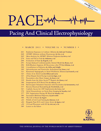Use of Cryoablation for Treatment of Tachyarrhythmias in 2010: Survey of Current Practices of Pediatric Electrophysiologists
Abstract
Background: Cryoablation for arrhythmia substrates in pediatrics has been available since 2003. The purpose of this study was to evaluate the current approach of pediatric electrophysiologists to the use of cryoablation in the current era.
Methods: We sent an Internet link to an online survey to all members of the Pediatric and Congenital Electrophysiology Society. Individuals and not institutions were surveyed.
Results: A total of 70 responses were received. Responding physicians were largely invasive pediatric electrophysiologists (94%) who practice at mid- to high-volume centers (>50 ablation procedures/year). Survey responders report that cryoablation was utilized for <50% of the ablation volume, and most utilize it for only 10%. With respect to specific arrhythmia substrates, 41% of responders use cryoablation as first-line therapy for atrioventricular nodal reentrant tachycardia. For accessory pathways, 94% report that cryoablation would only be utilized after mapping the accessory pathway to a “high-risk location.” Other arrhythmia substrates considered for cryoablation would be accessory pathways mapped to high-risk areas, junctional ectopic tachycardia, a parahisian ectopic atrial tachycardia, or an atrial tachycardia near the phrenic nerve.
Conclusion: For pediatric electrophysiologists who responded to the survey, radiofrequency energy remains the primary energy source for ablation. The current use of cryoablation technology is directed at arrhythmia substrates near the normal conduction system or other “high-risk” areas. (PACE 2011; 34:304–308)




